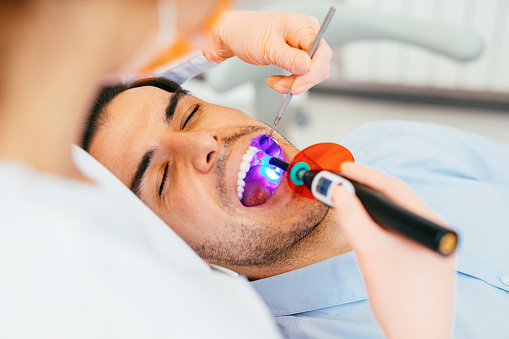
Dental Polymerization Lamps are used to cure light-curable resin-based dental composites. They work by photo-polymerization, which uses light energy to turn monomers into long chains of molecules called polymers. This process is the same as what makes synthetic materials and plastics strong and durable. It also allows for bonding between dental composites and teeth. This is an essential step in any tooth treatment, especially when it involves placing a filling. This can be a difficult task to accomplish without the right tools.
Before the development of these lights, it was impossible to fully polymerize resin based composites in the mouth. A dentist had to mix two separate materials: the A material and the B material. Once both were applied, they would need 30-60 seconds for the resin to harden. This process was inconvenient and time consuming, especially for busy practices. The results were inconsistent.
Many different types of light-curing devices are available. Each device has unique features and benefits. The best choice for a dentist will depend on the type of composite they are working with and the clinical application. Choosing a light-curing device that matches the clinician’s needs will improve efficiency and quality of care.
A dental curing light is a device that emits blue or visible light in the visible spectrum to cure resin-based composites. They are designed to activate a photoinitiator, a molecule that absorbs a portion of the light energy and initiates a chemical reaction to polymerize the composite. There are four different types of light-curing devices available are: tungsten halogen, arc, plasma arc, and LED.
The Dental Polymerization Lamps Market is anticipated to reach a value of US$ 280.3 million in 2023 and grow at a CAGR of 7.75% from 2023 to 2030.
The tungsten halogen (QTH) units were the first visible curing lights used in dentistry. They consisted of a tungsten filament in a quartz case with a halogen gas inside. These were able to deliver high-intensity blue/visible light for curing resin-based composites.
Other devices used in the past included argon lasers, which emit a narrow wavelength of light to accelerate the polymerization of composite materials. These units were more effective than QTH curing lights, whereas they were not as versatile as LEDs.
The current standard for Dental Polymerization Lamps is LED technology, which has a number of advantages over traditional tungsten and other sources. Compared to arc and plasma arc systems, LEDs offer superior power densities, a wider range of emission modes, and a longer lifespan. This has made them the preferred option for most dentists. The ideal curing light for any dental practice should have a wide emission window of the light probe, a minimal drop off in energy as it is moved further away from the resin composite (collimated beam), and ease of use and maintenance. A new file for reciprocating preparation, MicroMega One RECI was launched by COLTENE Group in June 2021.

